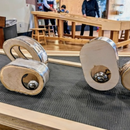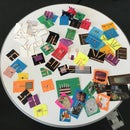Introduction: Tinkering With LEGO: Sound Machines
In our Tinkering Studio workshop space at the Exploratorium, we've discovered that LEGO pieces offer lots of possibilities for tinkering with motions, mechanisms, and linkages. One exploration that we've tried is building machines to play sound using a mix of LEGO technic pieces, musical instruments, and extra materials. We've found that creating a custom pegboard that works with LEGO technic pins and beams will make the linkage exploration more playful and iterative.
This guide will show you how to make the pegboard wall that fit Lego technic pins with proper spacing to attach beams and bricks. We've also included a LEGO parts list, files for a custom 3D printed part, and some ideas of how to get started building sound makers.
We recommend that you take this guide and customize it to fit your needs. Mess around with different materials and configurations of the pegboards, experiment with different instruments, and create you own custom mix of LEGO parts and everyday objects. Please share your ideas and designs with us as we continue to develop interesting ways to tinker with LEGO and build new parts that can help make that process easier.
Step 1: Laser Cut the Peg Board
For the basic board, you will need the following materials and tools.
Materials:
- 12"x16" piece of 1/4 in. plywood or acrylic (for laser cutting)
- 12 in. long 2x4
- 2 flat head wood screws
Tools:
- Laser Cutter (We are using a Universal Versa Laser with a 12x16 inch bed)
- Philips Head Screwdriver or Power Drill with a driver bit
For laser cutting:
Download the attached .ai file which has a hole pattern compatible with the LEGO technic hole size and spacing. Use the illustrator file to lasercut a full sized 12x16 in pegboard panel (with a usable space of 11.5 x 15.5 once the file is cut) or feel free to edit in illustrator to create a custom sized boards.
Place the piece of plywood or acrylic on the laser cutter bed and cut out the LEGO technic hole pattern according to your machine's specifications for 1/4 in material.
Attachments
Step 2: Attach the Base to the LEGO Peg Board
Attach the pegboard to the 12" piece of 2x4 using wood screws through one hole one each side to create a stable base for your LEGO tinkering explorations.
For acrylic bases you will need to use button head screws and washers to prevent stress on the plastic.
Step 3: Lego Parts List
We've made a LEGO parts list on Brick Owl website so you can see the parts and quantities for the parts that we are using to explore sound machines.
Tinkering with LEGO: Sound Machines Parts List
This is a comprehensive parts list of what we usually put out for our workshop at the Exploratorium. You might not need all the parts to create one sound machine, but the wide variety of pieces is good to have on hand to explore different ways of creating sound. With this basic set, you'll be able to make an diverse set of machines to create many different designs that produce a wide variety of rhythms and patterns.
Step 4: 3D Printed Holder
When you explore linkage mechanisms to play various instruments, it can be helpful to use a mallet or a stick to play percussion instruments such as xylophone, tambourine, triangle, etc. We've created a 3D printed holder that has a hole pattern compatible to LEGO technic pieces. With this custom holder, you can easily attach a mallet to your machine.
Go to the following link on Thingiverse and download the file for 3D printing.
3D printed mallet holder for LEGO tinkering
We use an Ultimaker 2 printer in our workshop to make the pieces, but it should work with a wide variety of 3D printers. After you print the piece, prepare it for the machine by adding a nylon set screw. With a tap (http://www.mcmaster.com/#26955a43/=11v75pv) and a tap driver (http://www.mcmaster.com/#26955a43/=11v75pv) create threads in the screw hole on top of the circle. The nylon screw (http://www.mcmaster.com/#91244A135) holds the mallet in place.
Again, this is a part that is useful for your sound linkage explorations, but it is not a must have part. If you do not have a 3D printer, skip this step and try to think alternative ways to attach a mallet to your machine. You can use masking tape or zip ties. You can also hot glue a clothespin or a binder clip to a LEGO piece to allow for the possibility of easily clipping in different unusual materials.
Step 5: Musical Instruments and Other Materials to Collect
Collect some musical instruments for your sound linkage explorations!
- bells
- toy xylophones
- tambourines
- cymbals
- triangles
- egg shakers
- maracas
- wind chimes etc..
We've also found that everyday objects can make interesting sounds by shaking, tapping, or scraping.
- tin cans
- copper tubes
- tooth brushes
- hair comb
- film canisters filled with beads
- spoons etc..
Try to build a linkage motion to play sound or make noise from these materials!
Step 6: Starting Points
There are several ways to mount a LEGO motor on the pegboard. We've used either lego beams and pegs or machine screws with nuts to solidly attach motors to the board.
The video shows some examples of basic linkage motions that will help you to get started. We usually encourage people to start with a slow speed. Adjust the motor speed to 2 or 3 on the rechargeable battery pack. Slowing down will help you to pay close attention to the motion, rhythm, direction, and force of your linkage mechanism. Explore the various mechanisms that can turn the motor's circular motion into tapping, sweeping, poking, or waving motion so that it plays rhythmic sounds!
Step 7: Creating an Environment for Tinkering
If you plan to share this activity with others in a school, library or makerspace, here are a few helpful tips that we've found support learners in their process of tinkering with sound machines.
Our dogbone shaped tables provide shared working spaces for people to see ideas that other are working on, share their process, and learn from each other. This social scaffolding helps participants stay engaged and introduces many new challenges and solutions.
The tinkering studio workshop is a facilitated environment and we constantly practice helping learners follow their own ideas, work through failure and frustration, and make connections between people and projects. Having friendly, open and approachable facilitators in the space creates a environment to allow for fun, experimentation, and collaboration.
The LEGO pieces are small and often look similar to each other so we think a lot about how to arrange the materials on the table. We often use metal cafeteria trays or paper food containers to sort out different categories of parts. Having the pieces easily accessible encourages experimentation and iteration as people build their sound machines.
Offer a space for people to combine their sound making elements to create a collaborative soundscape. Displaying the collection of sound machines creates an inspiring inspiration and generates many ideas for participants trying the activity.
Step 8: Take It Further
You can experiment with the size and material of the peg board. Having a big space to connect many motors and machines together on a huge piece of pegboard could produce an orchestral arrangement.
After you explored linkages with sound, how about creating a robot with linkage arms to accomplish some tasks for you? We've built a breakfast machine with a linkage arm, a machine to brush your teeth, and a machine with chopsticks. The 3D printed holder works great to hold an everyday object like a spoon and toothbrush. Adding extra materials to the LEGO linkages often make the exploration more purposeful, personally meaningful, and fun!
The linkage possibilities are endless. Share your ideas and discoveries with us in the comment column as we continue to develop interesting ways to tinker with LEGO and linkage mechanisms.















